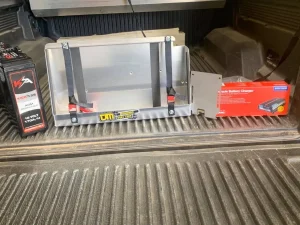A reliable 12V battery setup is the heart of any off-grid adventure. Be it camping in the bush, riding the remote tracks in your 4WD, or driving a caravan to far distances, with the correct electrical system you will find that the things that matter, such as fridges, lights, water pumps, and even coffee machines, will continue to operate without concern.
We have been assisting Australians to explore with confidence at TJM Bendigo over the decades. Being experienced in 4WD accessories, auto electrics and caravan power systems, we understand what it takes to create a safe, reliable and long lasting 12V system.
What is a 12V Battery Setup? (Beginner-Friendly Guide)
A 12 V battery system is a small power system that will power your appliances and accessories outside of the mains power. imagine it is your mobile electricity grid- ideal off-grid camping, caravans, camper trailers, boats and 4wd touring.
Here’s how it works:
- Your 12V deep-cycle battery stores energy.
- Appliances like fridges, lights, or pumps draw power from the battery.
- A charger or solar panel keeps the battery topped up.
One thing you need to know is the difference between starter batteries (those batteries you use to start your car engine) and deep-cycle batteries (those batteries that are intended to discharge at a slow, steady rate to power your accessories). Correct 12V installation should always be employing deep cycle batteries like AGM, Lithium, or Gel.
Here at TJM, we have installed thousands of systems in the hands of the Aussies traveller population – assisting them in building dependable off grid power solutions, be it weekend campers or full time caravans.
Choosing the Best 12V Battery Setup for Your Needs
When it comes to finding the best 12V battery setup, it depends on how, where, and what you travel with.
For Camping – Lightweight & Portable
When all you are doing is running a fridge, lights and possibly charging phones then you can probably get by with a portable battery box or power pack. They are light and convenient, and can be charged either by solar or by your vehicle.
For 4WD Touring – Dual Battery Systems
Touring arrangements usually have fridges, lights, radios and occasionally winches. The gold standard would be a dual battery configuration with a DC-DC charger. It makes sure that your accessories never empty your starter battery.
For Caravans & RVs – Large Storage & Solar Integration
The caravan arrangements are normally more capacity-demanding. Consider several deep-cycle or lithium batteries, solar panels, and inverters, and support appliances such as microwaves or CPAP machines, etc.
For Work Vehicles – On-Site Power
Tradies usually operate heavy tools, compressors or floodlights. Such installations typically demand a large capacity battery and inverter which is integrated into a robust system that can endure day to day operation.
Step-by-Step Guide – Planning Your 12V Battery Setup
Good planning is everything when it comes to constructing a 12V battery setup. One of the things you need to do is carry out a bit of pre-working on your system to guarantee that it is safe, reliable, and able to drive all the stuff you want on the road. The following is a guide of a few steps that can assist you in getting it right.
Step 1 – Work Out Your Power Needs
Begin by listing all appliances you will be operating such as portable fridge, driving lights, water pump or inverter. Record their size (wattage) and the length of time you will be using them every day. All of that summed up will give you a clue of the number of amp-hours (Ah) you will require each day.
Step 2 – Select Your Battery Size & Type
Once you know your power requirements, pick the right battery:
- Small camping setups: 100Ah AGM or Lithium battery.
- Touring & 4WD setups: 200–300Ah Lithium for fridges, lights, and charging gear.
- Caravan setups: 300–600Ah, often paired with solar panels for long-term off-grid use.
Step 3 – Add Charging Options
To keep your battery topped up, include at least one charging method:
- DC-DC charger from your vehicle’s alternator.
- Solar panels with regulator for off-grid charging.
- Mains charger for caravan parks or at-home charging.
Step 4 – Wiring, Fuses & Safety
This is where safety counts. Cables, isolators, and fuses should be used of the proper size to avoid electrical faults and overheating.
Step 5 – Test and Maintain Your System.
After installing, make sure your connections are fine, keep an eye on your battery, and charge often. Some simple repairs will allow your system to be useful in the years to come.
DIY 12V Battery Setup vs Professional Installation
Some adventurers prefer DIY, while others trust experts. Let’s compare:
DIY Advantages
- Lower cost if you’re handy with tools.
- Flexibility to customise your system.
DIY Risks
- Incorrect wiring can cause fires.
- Poor setup may damage batteries or appliances.
- No compliance or warranty on mistakes.
Why Choose Professional Installation at TJM
At TJM Bendigo, we’ve installed thousands of 12V systems for campers, 4WDers, and caravan owners. Our experience means your setup is:
- Professionally designed.
- Safe and compliant with Australian standards.
- Backed by trusted brands and warranties.
Many travellers who start DIY eventually come to us to fix issues—saving time and money in the long run.
Maintenance & Safety Tips for Your 12V Battery Setup
- Charge correctly – Avoid deep discharging below 50% (unless lithium).
- Use proper cabling & fuses – Undersized wires cause overheating.
- Ventilation – Prevents heat buildup in enclosed spaces.
- Regular inspections – Check for corrosion, loose terminals, or swelling.
- Monitor battery health – Use battery monitors or smart chargers.
These small steps extend the lifespan of your setup and keep your trips trouble-free.
Why do you need TJM Bendigo to install your 12V battery?
With a 12V battery system, you want more than just those parts, you want reliability, safety, and a system that is made to last. It is what we provide at TJM Bendigo. We have been supporting travellers, campers and 4WD enthusiasts to power up their adventures over the years.
Expertise You Can Rely On
Our team possesses many decades of practical experience in 4WD electric systems, caravan systems and off-grid power solutions. We do not buy into the one-shoe fits all mentality- each car is unique, each adventure is unique, and your power system must be equally unique.
Custom Solutions for Every Lifestyle
You may be off on a weekend of camping, towing a caravan around Australia, or using your work vehicle to drive tools on-site, we will design a system that suits you. We have you covered with our offerings of a dual battery system to complete caravan solar integrations.
Only the Best Brands
The brands we deal with such as Redarc, Enerdrive and our own brand of products are known to be tough enough to make it in Australia. These brands are reputed with reliability, efficiency and performance over the long term.
Safety and Compliance First
Your safety matters. All our installed systems are well wired, fused and tested in accordance with Australian safety requirements. It implies that you can travel on the road without worrying that your power configuration is unsafe, unreliable or that it will not last.
Local Support You Can Count On
Being based in Bendigo means we’re here when you need us – be it advice, servicing or upgrades.
At TJM Bendigo, we don’t just build battery systems – we build peace of mind.




